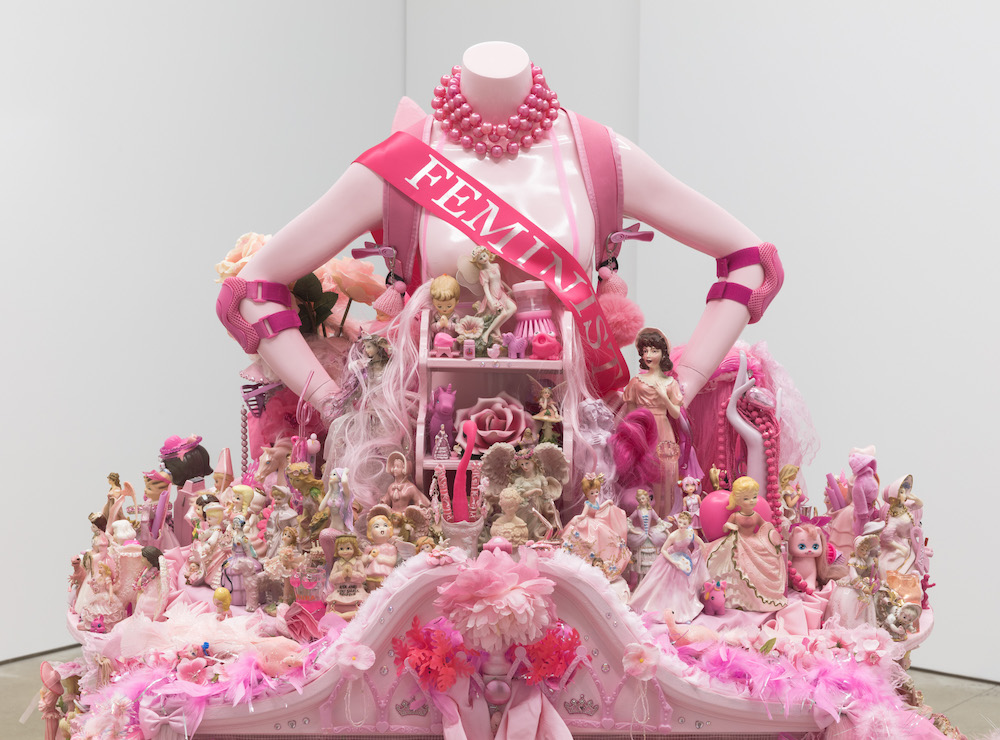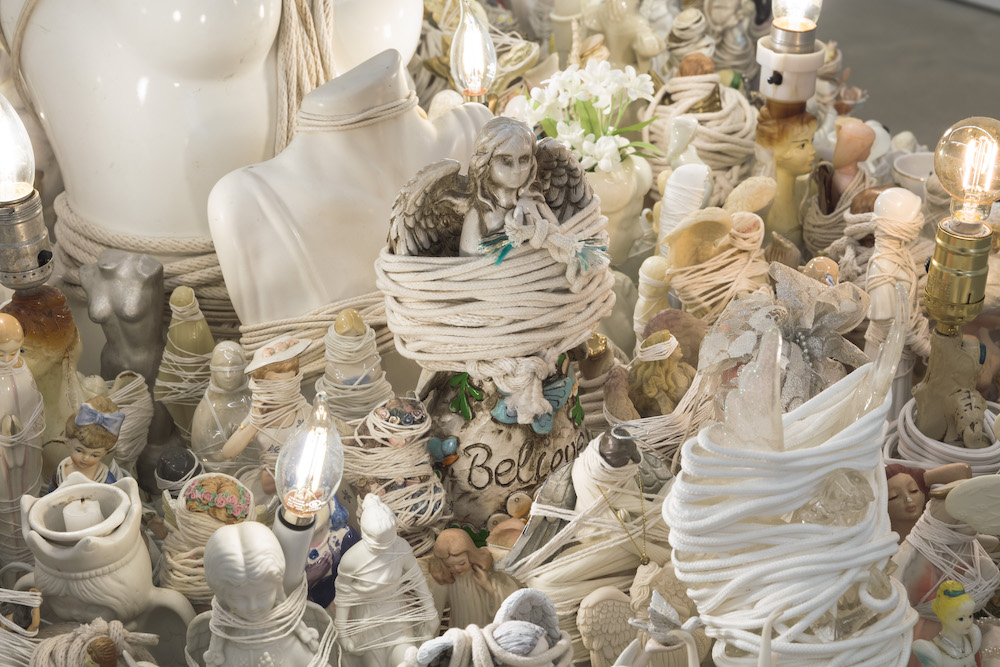Artist, feminist, environmentalist—these themes elegantly converge in her exhibition “Bound Angel” which examines, with perverse pleasure, the darker cultural implications of mass production, the fight for gender equality, and the mounting ecological crisis. Accumulating thousands of consumer products as metaphors for identity formation under capitalism, Munson creates haunting sculptures that reveal the violence these objects commit against female bodily autonomy and the environment at large.
The stunning titular installation, Bound Angel (2021) comprises found figurines in the shape of female angels as well as other objects connoting femininity—porcelain collectibles, nightlights, snow globes, candles, nude statuettes—crowded atop a large oval dining table. All The objects are painstakingly bound and stifled by string, rope, and extension cords to reveal the terror and victimization lurking beneath seemingly commonplace products. Rising from the center of the tablecloth made from pieces of wedding gowns is a tilted, faceless mannequin, struggling against her binds; the entire sculpture is the form of an incapacitated, suffocating bride.
The form of Bound Angel is immense, almost malign in the way it spills from the edges of the table. Individually, these trinkets are trivial and harmless but taken altogether, they acquire a far more sinister quality. As Munson cleverly points out through this parallel, the oppressive impact of our over-saturated, mass-produced cultural economy is insidious and inescapable.

Portia Munson, Today Will Be Awesome, 2021, found pink objects, pink synthetic fabric & cloths, mannequin, salvaged round bar table and a deconstructed secretary desk/cabinet, Courtesy of Portia Munson and P•P•O•W, New York. Photo: Lance Brewer
Flanking the installation are five new works from Munson’s “Serving Trays” (all 2022) series, in which entangled female figurines are displayed on burnished antique trays. The series incites contemplation of how candidly portions of culture are served up on silver platters to voracious consumers. In turn, women’s bodies become mere commodities, incessant delicacies dished out for the pleasure of the masses. In her ironically titled Today Will Be Awesome(2021), Munson amasses heaps of pink knickknacks produced to sell a vision of beauty to women and girls—dolls, cosmetic products, undergarments, jewelry, evening gloves, tutus and fake flowers, among others. The sculpture takes the form of a headless pink mannequin donning elbow pads, a backpack and a sash that reads FEMINIST whose overflowing skirt of mass-produced articles is torn open to reveal a glassy pink figure curled in the fetal position at her feet. The accretion of objects comments on the arbitrariness of pink as a signifier of femininity exposes the underlying history of persecution and control associated with each item produced to enforce one-dimensional beauty tropes.
Sixty still life drawings from Munson’s ongoing “Functional Women” (2017-2022) series underscore her earnest treatment of the objects she collects. Echoing the iconography of bound wrists, big-breasted busts and sensual innuendos latent in the sculptures, these drawings witness women’s bodies as valuable only if they take on countless extraneous functions that Munson reimagines with disturbing elegance—women as lighters, perfume bottles, salt shakers, vases, nutcrackers and bottle openers. Tied in with her commentary on how consumer commodities degrade women, Munson also reviles them for their destructive environmental impacts. After all, everything she has accumulated is essentially non-biodegradable plastic junk that has been spared from landfills. She forces viewers to confront not only the evidence of their collective crimes against nature, but also the futility and cruelty of manufacturing objects designed to deride women. By bringing the objects together in this way, Munson reinvents them as monuments of resilience and retaliation for womankind and for the planet.


